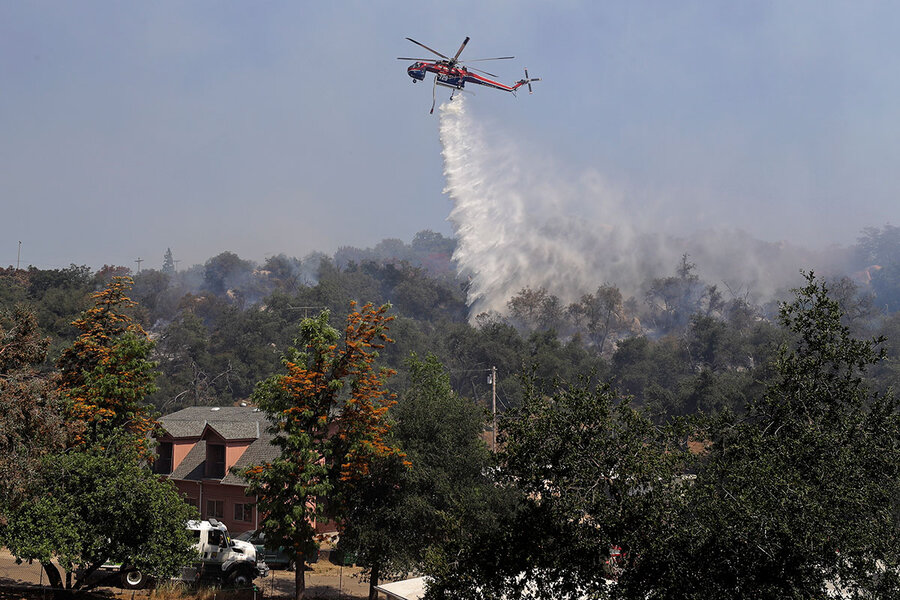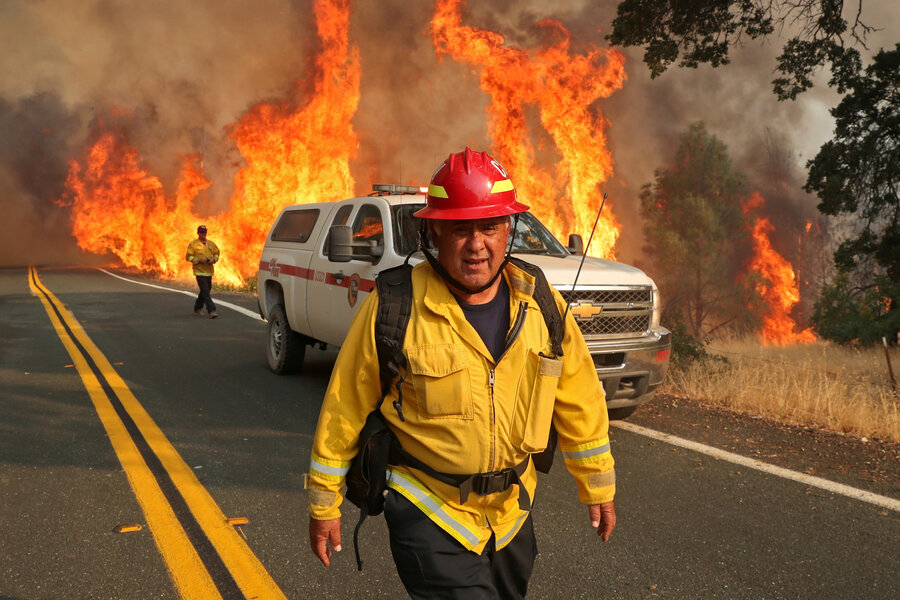California asks, who is responsible for wildfire safety?
Loading...
| Sacramento, Calif.
The number and intensity of wildfires has grown in recent years, especially in California. Last year alone, nearly 10,000 fires consumed 4.2 million acres of land in the state, killing 33 people and causing about $10 billion in damage.
It’s particularly problematic in areas where development meets natural lands. Eleven million Californians live within this wildland-urban interface – more than a fourth of the population. Add to this a drought and desperate need for more housing, and the perils are clear.
Why We Wrote This
As residential sprawl feeds ever-more destructive infernos, California seeks to save homes and lives by taking aim at local control over land-use planning, appealing to a sense of shared responsibility to minimize risks.
Attempting to address the risks, state lawmakers are butting up against property owners, developers, and local control over who gets to build and where. The attorney general’s office has joined a pair of lawsuits that would block two housing developments, citing developers’ insufficient consideration of potential wildfire dangers. Proposals in the Legislature take aim at local planners and at homeowners to block or redefine new construction and to urge existing communities to become more fire-adaptive.
The collective measures call on Californians to share responsibility for fire safety statewide.
“Once the fire starts, it’s too late,” Democratic Assembly Member Jim Wood of Santa Rosa tells The Sacramento Bee. “That preparation work needs to start happening right now.”
The wildfires that ravaged California last year left behind a scorched landscape and a rubble pile of unsettling numbers.
Some 9,900 fires burned more than 4.2 million acres and destroyed almost 10,500 homes and other buildings, killing 33 people and causing an estimated $10 billion in damage. The devastation included five of the six largest infernos in state history – and the first to exceed 1 million acres – and forced tens of thousands of residents to flee their homes as flames threatened towns and cities alike.
As much as ailing natural lands, forest mismanagement, and climate change, residential sprawl has contributed to an increase in catastrophic blazes across the West. Studies show that half to three-fourths of the homes razed by wildfires in California fall within the wildland-urban interface, broadly defined as areas where development meets natural lands and where 11 million people live statewide.
Why We Wrote This
As residential sprawl feeds ever-more destructive infernos, California seeks to save homes and lives by taking aim at local control over land-use planning, appealing to a sense of shared responsibility to minimize risks.
The housing density in fire-prone settings feeds infernos as wind-blown embers flit from rooftop to rooftop. In recent years, seeking to break that chain reaction, the state has mandated use of fire-resistant building materials for new housing and required property owners to clear dead vegetation around homes to deprive fires of fuel.
The modest results of the policies have prompted the state – in the courts and the Legislature – to seek to rein in residential growth by imposing greater control over local land-use planning. The tough-love strategy to save homes and lives occurs as drought imperils California, with wildfires burning 14,000 acres through May 9, or 12,000 more than at the same time last year.
What legal action has California taken to try to limit new housing in fire-prone areas?
The state attorney general’s office joined a pair of lawsuits in March that environmental groups brought against San Diego County to halt two projects that would add 3,000 housing units on almost 2,000 acres of scrubland outside Chula Vista. The decision followed a similar move a month earlier in Lake County, where developers seek to build 1,400 homes and 850 hotel and resort units on 16,000 acres of rolling grasslands north of San Francisco.
In court filings, then-Attorney General Xavier Becerra, who since has become secretary of the U.S. Department of Health and Human Services, asserted that county officials neglected to adequately analyze wildfire risk before approving the plans. His “motion to intervene” in San Diego County points out that 68 fires have burned within five miles of the project site over the past 100 years. In Lake County, wildfire has struck the proposed development area four times since 2014, including last summer.
The state’s action arises from an update to the California Environmental Quality Act (CEQA) in 2018 that directs local officials to evaluate the threat that wildfire poses to a new development. San Diego and Lake county officials insist they sufficiently assessed the risk, and further contend that the projects would address a shortage of housing – an ongoing statewide crisis – and provide much needed property tax revenue to fund schools and roads.
The CEQA changes have also cast into limbo a proposal to build 19,300 homes on 6,700 acres in rural Los Angeles County. A judge there blocked construction last month after finding that the developer failed to properly consider the project’s potential impact on wildfire danger in the region.
What measures are state lawmakers proposing to curb construction in high-risk fire zones?
State Sen. Henry Stern has introduced a bill to ban new housing in areas identified as “very high fire hazard severity zones” by the California Department of Forestry and Fire Protection, known as Cal Fire.
The Democrat from the Southern California enclave of Calabasas lost his home to wildfire in 2018. His legislation takes aim at the primacy of local control, stating that “approval of a new development within a zone of high fire danger ... is a matter of statewide concern and is not a municipal affair.”
Senator Stern has described the bill as “a wake-up call” to show that planning decisions carry consequences beyond a city’s or county’s borders in the form of escalating costs borne by state taxpayers for firefighting, emergency response, and disaster relief.
Cal Fire designates high-risk fire zones based on terrain, vegetation, moisture levels, and weather patterns. The size and number of those areas, where almost 3 million people live, continue to grow as the climate turns warmer and drier.
Sen. Mike McGuire, a Democrat from Healdsburg, has written a measure that would force cities and counties to adopt new state fire safety standards to build housing in high-risk fire zones, with stronger protections for larger projects.
The bill would prohibit local officials from approving a development that lacked clear evacuation routes, access points for first responders, vegetation fuel breaks, and other safeguards. “If certain common-sense health and safety requirements can’t be met,” he said late last year, “we shouldn’t be building at all.”
How is California trying to nurture a sense of shared responsibility for wildfire prevention and safety?
Gov. Gavin Newsom signed a $536 million wildfire budget bill last month that provides $25 million to help homeowners retrofit houses with fire-resistant materials. The “home-hardening” pilot program will enable the state to pursue an additional $75 million in federal funding to expand the effort.
The U.S. Forest Service’s guidelines for creating fire-adapted communities include building and retrofitting houses to withstand wildfires and clearing dead vegetation from around homes – crucial precautions for residents living in the wildland-urban interface.
A pair of bills would encourage individual and collective participation in developing fire-adapted communities. Senator Stern has proposed establishing statewide training and grant programs to entice property owners to retrofit their homes and comply with “defensible space” requirements for removing vegetation around homes.
Another measure would create a $50 million program within the state’s Department of Conservation to assist local and regional leaders with fostering fire-adapted communities. Democratic Assembly Member Jim Wood of Santa Rosa, who wrote the legislation, has gained grim familiarity with the toll of wildfires through his work as a forensic dentist, helping authorities identify victims of recent infernos in Northern California.
“We need to prepare for fire season like we are preparing for an impending hurricane,” he told The Sacramento Bee last month. “Once the fire starts, it’s too late. That preparation work needs to start happening right now.”









